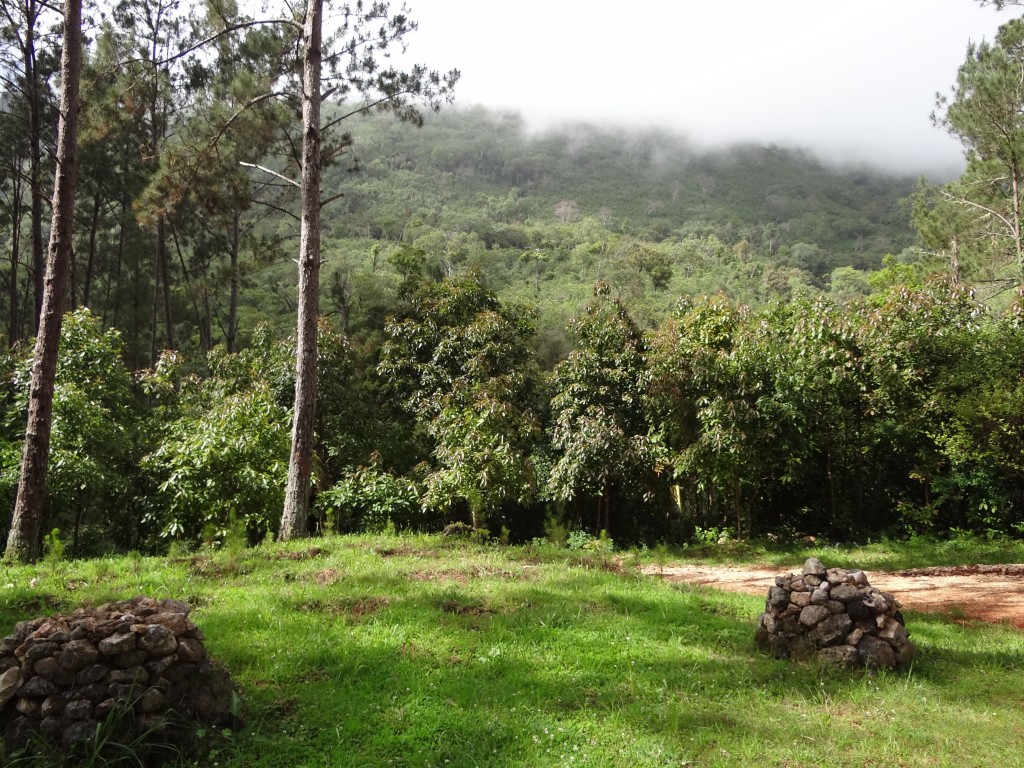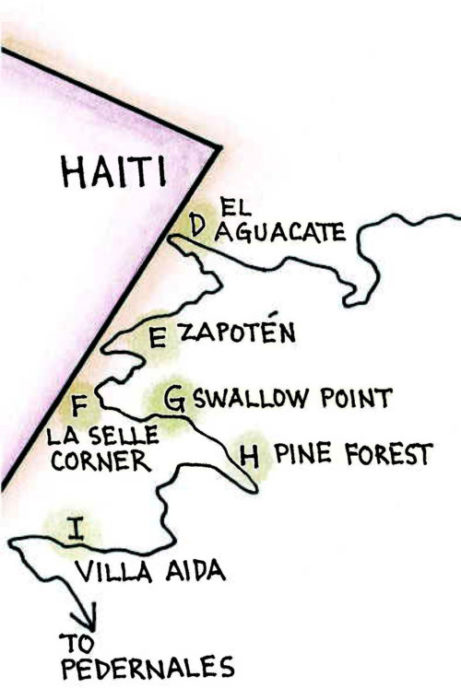Aguacate and Zapotén
The Sierra de Bahoruco is Hispaniola’s premier birding area. Accessing these north-slope sites will bring you into a variety of habitats, including dry forest, semi deciduous forest, humid broadleaf forest, cloud forest, mid-montane grasslands, and pine forest. Of the 31 Hispaniolan endemics, only Ridgway’s Hawk and Eastern Chat-Tanager are not found in the area. Even the Gray-headed Palm-Tanager, essentially a Haitian endemic, has been rarely reported to cross into the Sierra de Bahoruco near Aquacate. The outstanding feature of the Bahoruco’s north slope is the montane broadleaf evergreen forest or cloud forest, which is marked by large tree ferns at about 1,200 m elevation.

Beginning above Zapotén, this is the best site for high-elevation endemics such as the Scaly-naped Pigeon, White-fronted Quail-Dove, Hispaniolan Emerald, Hispaniolan Trogon, Narrow-billed Tody, Rufous-throated Solitaire, La Selle Thrush, Green-tailed Ground-Tanager, Hispaniolan Highland-Tanager, Western Chat-Tanager, Hispaniolan Spindalis, Antillean Euphonia, and Antillean Siskin. Be advised, however, that in order to maximize the chance of seeing the most difficult species, such as the threatened La Selle Thrush, you should arrive before dawn. This means, however, leaving Barahona at 3:00 A.M. in order to reach this area at the break of dawn.
There are six birding stops between the Aguacate checkpoint and Villa Aida as one climbs the north slope of the Sierra de Bahoruco.

Aguacate – Aquacate and Zapoten are moist broadleaf zones and the beginning of the cloud-forest zone. The Loggerhead Kingbird is frequently seen here. Aguacate is also a good place to look for endemic Hispaniolan Parakeets as well as the locally common Olive-throated Parakeet. Finally, keep an eye out for the Gray-crowned Palm-Tanager which has been recorded at this point. Be sure not to confuse this species with the very similar juveniles of the common Black-crowned Palm-Tanager.
Zapotén and La Selle Corner – Approximately 5 km (3.1 miles) beyond Aguacate, the road enters a brief stretch of pine forest, and then arrives at Zapotén where there is a new guard house. It is best, however, to continue 2 km (1.2 miles) beyond Zapotén and park at the bend in the road known as La Selle Corner. Here you are on the lower edge of the cloud-forest zone. The White-fronted Quail-Dove will often forage in the road, and the Western Chat-Tanager may be heard calling nearby.
Swallow Point – Located another 1 km (0.6 mile) above La Selle Corner, Swallow Point is a good, clear lookout across the lower elevations of the Bahorucos. This is a particularly good place to see the threatened Golden Swallow which here, in season, may be seen entering a nesting cavity in a small cliff. From here the road continues through cloud forest for another 3-4 km (1.9 – 2.5 miles) before entering the main pine forest.
Pine forest – Beyond Swallow Point the forest soon turns to primarily pine, sometimes with a broadleaf component to the understory. Listen closely for the irregular metallic clacking of the Hispaniolan Crossbill, which is often heard before it is seen. Antillean Siskin and Greater Antillean Elaenia are also partial to pine forests, as is the increasingly rare Plain Pigeon.
Villa Aida – Villa Aida, a typical pine savannah, lies approximately 6 km (3.7 miles) from La Selle Corner. In the December-February period you may hear after dusk the mournful calls of the critically endangered Black-capped Petrel. This species is known to nest on the cliffs of the nearby Loma de Toro.
Target species include Black- capped Petrel, Sharp- shinned Hawk, Scaly- naped Pigeon, Plain Pigeon, White- fronted Quail-Dove, Olive- throated Parakeet, Hispaniolan Nightjar, Hispaniolan Emerald, Hispaniolan Trogon, Narrow- billed Tody, Antillean Piculet, Yellow- bellied Sapsucker, Greater Antillean Elaenia, Loggerhead Kingbird, Tree Swallow, Golden Swallow, Rufous- throated Solitaire, Bicknell’s Thrush, La Selle Thrush, Magnolia Warbler, Black- throated Blue Warbler, Yellow- rumped Warbler, Black- throated Green Warbler, Yellow- throated Warbler, Pine Warbler, Green- tailed Ground- Tanager, Hispaniolan Highland- Tanager, Gray- crowned Palm- Tanager, Western Chat- Tanager, Hispaniolan Spindalis, Black- faced Grassquit, Antillean Siskin
Follow the directions from Barahona towards Rabo de Gato and Puerto Escondido (Site B10); be sure to pay your entrance fee at the park house in Puerto Escondido. To continue on to Aguacate and Zapotén, turn right at the Puerto Escondido T-intersection, pass by the military guard post on the right, and then continue through the valley dominated by large avocado plantations. Pass the birding sites at La Placa and Los Naranjos. About 3 km (1.9 miles) further on, the road enters a (normally) dry riverbed full of loose stone after which the road begins to ascend more steeply. This will require high ground clearance and possibly 4WD, though much depends on recent weather and road maintenance. Stop at the military guard post at Aguacate and tell them you are a birdwatcher (observador de aves), at which point they may request your entrance ticket.
- Entrance fee: Dominicans $RD 20, Foreigners $RD 50
